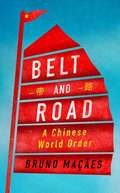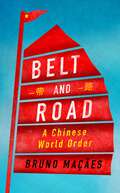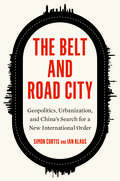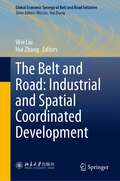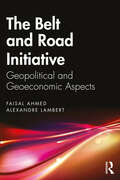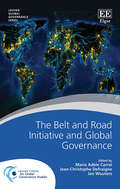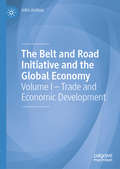- Table View
- List View
Belonging in Changing Educational Spaces: Negotiating Global, Transnational, and Neoliberal Dynamics (Routledge Research in International and Comparative Education)
by Karen Monkman Ann FrkovichThis book explores the impacts on personal and professional, local and global forms of belonging in educational spaces amidst rapid changes shaped by globalization. Encouraging readers to consider the idea of belonging as an educational goal as much as a guiding educational strategy, this text forms a unique contribution to the field. Drawing on empirical and theoretical analyses, chapters illustrate how educational experience informs a sense of belonging, which is increasingly juxtaposed against a variety of global dynamics including neoliberalism, transnationalism, and global policy and practice discourses. Addressing phenomena such as refugee education, large-scale international assessments, and study abroad, the volume’s focus on ten countries including Japan, Sierra Leone, and the US demonstrates the complexities of globalization and illuminates possibilities for supporting new constructions of belonging in rapidly globalizing educational spaces. This text will benefit researchers, academics, and educators with an interest in international and comparative education, multicultural education, and educational policy more broadly. Those interested in the sociology of education and cultural studies within education will also benefit from this volume.
Belonging in Changing Educational Spaces: Negotiating Global, Transnational, and Neoliberal Dynamics (Routledge Research in International and Comparative Education)
by Karen Monkman Ann FrkovichThis book explores the impacts on personal and professional, local and global forms of belonging in educational spaces amidst rapid changes shaped by globalization. Encouraging readers to consider the idea of belonging as an educational goal as much as a guiding educational strategy, this text forms a unique contribution to the field. Drawing on empirical and theoretical analyses, chapters illustrate how educational experience informs a sense of belonging, which is increasingly juxtaposed against a variety of global dynamics including neoliberalism, transnationalism, and global policy and practice discourses. Addressing phenomena such as refugee education, large-scale international assessments, and study abroad, the volume’s focus on ten countries including Japan, Sierra Leone, and the US demonstrates the complexities of globalization and illuminates possibilities for supporting new constructions of belonging in rapidly globalizing educational spaces. This text will benefit researchers, academics, and educators with an interest in international and comparative education, multicultural education, and educational policy more broadly. Those interested in the sociology of education and cultural studies within education will also benefit from this volume.
Belonging in Translation: Solidarity and Migrant Activism in Japan (Global migration and social change)
by Reiko ShindoThis is the first book to investigate how migrants and migrant rights activists work together to generate new forms of citizenship identities through the use of language. Shindo's book is an original take on citizenship and community from the perspective of translation, and an alluring amalgamation of theory and detailed empirical analysis based on ethnographic case studies of Japan.
Belonging in Translation: Solidarity and Migrant Activism in Japan (Global migration and social change)
by Reiko ShindoThis is the first book to investigate how migrants and migrant rights activists work together to generate new forms of citizenship identities through the use of language. Shindo's book is an original take on citizenship and community from the perspective of translation, and an alluring amalgamation of theory and detailed empirical analysis based on ethnographic case studies of Japan.
Belonging, Solidarity and Expansion in Social Policy
by S. BörnerThis book examines the relationship of belonging and social policy in a historical-comparative perspective reconstructing individual arguments in favour of or opposed to the expansion of solidarities.
Belorussia 1944: The Soviet General Staff Study (Soviet (Russian) Study of War)
by David GlantzA new edited translation of the Soviet Staff study of the Red Army's Belorussian operation in the summer of 1944, which was unprecedented in terms of its scale, scope and strategic consequences. The Soviet Stavka had planned a campaign consisting of a series of massive operations spanning the entire Soviet-German front. Four powerful fronts (army groups) operated under close Stavka (high command) control. Over 1.8 million troops acomplished a feat unique in the history of the Red Army: the defeat and dismemberment of an entire German army group. This book is a translation of the Soviet General Staff Study No 18, a work originally classified as 'secret' and intended to educate Soviet commanders and staff officers. The operation is presented from the Soviet perspective, in the words of the individuals who planned and orchestrated the plans. A map supplement, including terrain maps, is provided to illustrate the flow of the operation in greater detail.
Belorussia 1944: The Soviet General Staff Study (Soviet (Russian) Study of War #No. 12)
by David M. Glantz Harold S. OrensteinA new edited translation of the Soviet Staff study of the Red Army's Belorussian operation in the summer of 1944, which was unprecedented in terms of its scale, scope and strategic consequences. The Soviet Stavka had planned a campaign consisting of a series of massive operations spanning the entire Soviet-German front. Four powerful fronts (army groups) operated under close Stavka (high command) control. Over 1.8 million troops acomplished a feat unique in the history of the Red Army: the defeat and dismemberment of an entire German army group. This book is a translation of the Soviet General Staff Study No 18, a work originally classified as 'secret' and intended to educate Soviet commanders and staff officers. The operation is presented from the Soviet perspective, in the words of the individuals who planned and orchestrated the plans. A map supplement, including terrain maps, is provided to illustrate the flow of the operation in greater detail.
The Beloved Community: How Faith Shapes Social Justice from the Civil Rights Movement to Today
by Charles MarshA noted theologian explains how the radical idea of Christian love animated the African American civil rights movement and how it can power today's social justice strugglesSpeaking to his supporters at the end of the Montgomery bus boycott in 1956, Martin Luther King, Jr., declared that their common goal was not simply the end of segregation as an institution. Rather, "the end is reconciliation, the end is redemption, the end is the creation of the beloved community." King's words reflect the strong religious convictions that motivated the African American civil rights movement. As King and his allies saw it, "Jesus had founded the most revolutionary movement in human history: a movement built on the unconditional love of God for the world and the mandate to live in that love." Through a commitment to this idea of love and to the practice of nonviolence, civil rights leaders sought to transform the social and political realities of twentieth-century America. In The Beloved Community, theologian and award-winning author Charles Marsh traces the history of the spiritual vision that animated the civil rights movement and shows how it remains a vital source of moral energy today. The Beloved Community lays out an exuberant new vision for progressive Christianity and reclaims the centrality of faith in the quest for social justice and authentic community.
Below the Radar: How Silence Can Save Civil Rights (Studies in Postwar American Political Development)
by Alison L. GashIn 1993, the nation exploded into anti-same sex marriage fervor when the Hawaii Supreme Court issued its decision to support marriage equality for gay and lesbian couples. Opponents feared that all children, but especially those raised by lesbian or gay couples, would be harmed by the possibility of same-sex marriage, and warned of the consequences for society at large. Congress swiftly enacted the Defense of Marriage Act, defining marriage as between a man and a woman, and many states followed suit. Almost a decade before the Hawaii court issued its decision, however, several courts in multiple states had granted gay and lesbian couples co-parenting status, permitting each individual in the couple to be legally recognized as joint parents over their children. By 2006, advocates in half the states had secured court decisions supporting gay and lesbian co-parenting, and incurred far fewer public reprisals than on the marriage front. What accounts for the stark difference in reactions to two contemporaneous same-sex family policy fights? In Below the Radar, Alison Gash argues that advocacy visibility has played a significant role in determining whether advocacy efforts become mired in conflict or bypass hostile backlash politics. Same-sex parenting advocates are not alone in crafting low-visibility advocacy strategies to ward off opposition efforts. Those who operate, reside in, and advocate for group homes serving individuals with disabilities have also used below-the-radar strategies to diminish the damage cause by NIMBY ("not in my back yard") responses to their requests to move into single-family neighborhoods. Property owners have resorted to slander, subterfuge, or even arson to discourage group homes from locating in their neighborhoods, and for some advocates, secrecy provides the best elixir. Not every fight for civil rights grabs headlines, but sometimes, this is by design. Gash's groundbreaking analyses of these strategies provide a glimpse of the prophylactic and palliative potential of low-visibility advocacy.
Belt And Road: A Chinese World Order (PDF)
by Bruno MacaesChina's Belt and Road strategy is acknowledged to be the most ambitious geopolitical initiative of the age. Covering almost seventy countries by land and sea, it will affect every element of global society, from shipping to agriculture, digital economy to tourism, politics to culture. Most importantly, it symbolises a new phase in China's ambitions as a superpower: to remake the world economy and crown Beijing as the new centre of capitalism and globalisation. Bruno Maçães traces this extraordinary initiative's history, highlighting its achievements to date, and its staggering complexity. He asks whether Belt and Road is about more than power projection and profit. Might it herald a new set of universal political values, to rival those of the West? Is it, in fact, the story of the century?
Belt and Road: A Chinese World Order
by Bruno MaçãesChina's Belt and Road strategy is acknowledged to be the most ambitious geopolitical initiative of the age. Covering almost seventy countries by land and sea, it will affect every element of global society, from shipping to agriculture, digital economy to tourism, politics to culture. Most importantly, it symbolizes a new phase in China's ambitions as a superpower: to remake the world economy and crown Beijing as the new center of capitalism and globalization. Bruno Maçães traces this extraordinary initiative's history, highlighting its achievements to date, and its staggering complexity. He asks whether Belt and Road is about more than power projection and profit. Might it herald a new set of universal political values, to rival those of the West? Is it, in fact, the story of the century?
Belt and Road: A Chinese World Order
by Bruno MaçãesChina's Belt and Road strategy is acknowledged to be the most ambitious geopolitical initiative of the age. Covering almost seventy countries by land and sea, it will affect every element of global society, from shipping to agriculture, digital economy to tourism, politics to culture. Most importantly, it symbolizes a new phase in China's ambitions as a superpower: to remake the world economy and crown Beijing as the new center of capitalism and globalization. Bruno Maçães traces this extraordinary initiative's history, highlighting its achievements to date, and its staggering complexity. He asks whether Belt and Road is about more than power projection and profit. Might it herald a new set of universal political values, to rival those of the West? Is it, in fact, the story of the century?
The Belt and Road City: Geopolitics, Urbanization, and China's Search for a New International Order
by Simon Curtis Ian KlausAn exploration of how China’s Belt and Road Initiative seeks to reshape international order and how it has catalyzed a new era of infrastructural geopolitics Over the past decade China has put infrastructural and urban development at the heart of a strategy aimed at nothing less than the transformation of international order. The Belt and Road Initiative, which seeks to revitalize and reconnect the ancient Silk Roads that linked much of the world before the rise of the West, is an attempt to place China at the center of this new international order, one shaped by Chinese power, norms, and values. It seeks to do so, in part, by shaping our shared urban future. Simon Curtis and Ian Klaus explore how China’s specific investments in urban development—cities, roads, railways, ports, digital and energy connectivity—are directly linked to its foreign policy goals. Curtis and Klaus examine the implications of these developments as they evolve across the vast Afro-Eurasian region. The distinctive model of international order and urban life emerging with the rise of Chinese power and influence offers a potential rival to the one that has accompanied the rise and zenith of Western power, marking a new age of infrastructural geopolitics and Great Power competition.
The Belt and Road: Industrial and Spatial Coordinated Development (Global Economic Synergy of Belt and Road Initiative)
by Wei Liu Hui ZhangThis book mainly addresses China's Belt and Road Initiative in terms of the connectivity industrial and spatial development, as well as current world's economic and trade pattern under such synergy development, and focuses on the function and mechanism of industry and geography coordination. Although current research on the value circulation between China and developed economies is relatively adequate, the book focuses on the value circulation between the countries and regions, especially the developing economies. China and other developing countries tie strongly with the production value circulation. The coordination industrial and spatial development in the global value cycle is also the cornerstone of long-term stabilization and sustainable development in China. Therefore, this book provides the theoretical and empirical research on Belt and Road from the perspectives on industrial and spatial synergy. This book proposes several questions: Any inherent inlay between industrial and geographic allocation, i.e., is there any possibility for close integration? This book analyzes the necessity of coordinated development of industry and space perspective of production division. Secondly, from the perspective of historical evolution and current situation, it analyzes the relationship among industry, economic growth and fluctuation and compares realizing paths of synergy of industrial and spatial development. It contains the industry and spatial diffusion mechanism and the effect of synergy development. Moreover, the corresponding policy implication is provided for sustainable development through the Belt and Road Initiative.
The Belt and Road Initiative: Geopolitical and Geoeconomic Aspects
by Faisal Ahmed Alexandre LambertThis book studies the geopolitical and geoeconomic aspects of China’s Belt and Road Initiative (BRI). It argues that the BRI has the potential to redesign the spatial and territorial dimensions of governance and effectively counterbalance the hitherto predominant hegemonies of the Anglo-American sea power. The volume: Highlights the main geopolitical patterns, including geographical, economic, financial, technological, and strategic factors guiding the BRI on a global scale Presents a historical account of the development of the Silk Road and underlines its contemporary relevance Traces China’s growing inf luence from Eurasia to America Discusses how the Initiative is likely to transform international relations by the middle of the 21st century. A comprehensive guide to China’s rise as the new centre of gravity in global geopolitics, the book will be indispensable for students of political studies, geopolitics, international relations, and foreign policy. It will also be useful for policymakers, strategic investors, think tanks, and government officials.
The Belt and Road Initiative: Geopolitical and Geoeconomic Aspects
by Faisal Ahmed Alexandre LambertThis book studies the geopolitical and geoeconomic aspects of China’s Belt and Road Initiative (BRI). It argues that the BRI has the potential to redesign the spatial and territorial dimensions of governance and effectively counterbalance the hitherto predominant hegemonies of the Anglo-American sea power. The volume: Highlights the main geopolitical patterns, including geographical, economic, financial, technological, and strategic factors guiding the BRI on a global scale Presents a historical account of the development of the Silk Road and underlines its contemporary relevance Traces China’s growing inf luence from Eurasia to America Discusses how the Initiative is likely to transform international relations by the middle of the 21st century. A comprehensive guide to China’s rise as the new centre of gravity in global geopolitics, the book will be indispensable for students of political studies, geopolitics, international relations, and foreign policy. It will also be useful for policymakers, strategic investors, think tanks, and government officials.
The Belt and Road Initiative: An Old Archetype of a New Development Model
by Francisco José B. S. Leandro Paulo Afonso B. DuarteThis book is an analysis of the developments associated with the Belt and Road Initiative (B&RI) five years after Xi Jinping announced both the Silk Road Economic Belt (SREB) and the 21st Maritime Silk Road (21MSR). Together, these two dimensions constitute the B&RI, providing the so-called Chinese ‘project of the century’ with regional, inter-regional and global reach. This book aims at assessing the impact of the B&RI in all these dimensions and levels of influence. This is a current and promising theme, not only in the short and medium terms, but also within a broader timescale, reflecting Chinese strategic thinking itself, since Chinese philosophy and culture are oriented towards long-term and inter-generational perspectives. Likewise, both the title of this publication and the way it has been organized result from the empirical perception that China asserts a conservative attitude towards foreign affairs, redesigned in multiple dimensions, to create a perception of domestic unity and global prestige. In this vein of thought, the B&RI is already influencing and will continue to influence, directly or indirectly, the current economic and political order.
The Belt and Road Initiative: A Pathway towards Inclusive Globalization (China Perspectives)
by Liu WeidongThe Belt and Road Initiative (hereafter BRI) of China has attracted worldwide attention and participation, causing a lot of debate over its implications for international society. Although it is still in a budding stage, the BRI seems to afford a framework for an increasing number of countries to explore jointly new international economic governance mechanisms and offer significant opportunities for them to cope jointly with global challenges. Taking a globalization perspective and tracking the ancient silk roads, this book tries to examine the general context in which the BRI is raised and implemented, arguing that this Chinese initiative, instead of replacing existing international cooperation mechanisms, is a call for the reform and development of neoliberal globalization and will open up a new era of inclusive globalization. Inclusive globalization is neither an overturning nor a simple continuation of neoliberal globalization but rather a proposal capable of addressing the problems of existing globalization. The difference between them lies in the fact that globalization cannot only serve the "spatial fix" of capital but also has to meet the needs of living people. The book also addresses a number of major issues on building the Belt and Road and contains Chinese media’s interviews with the author on various BRI issues. Given the author has been intensively involved in the study of and planning for the BRI, the book offers a valuable academic insight into this Chinese initiative.
The Belt and Road Initiative: A Pathway towards Inclusive Globalization (China Perspectives)
by Liu WeidongThe Belt and Road Initiative (hereafter BRI) of China has attracted worldwide attention and participation, causing a lot of debate over its implications for international society. Although it is still in a budding stage, the BRI seems to afford a framework for an increasing number of countries to explore jointly new international economic governance mechanisms and offer significant opportunities for them to cope jointly with global challenges. Taking a globalization perspective and tracking the ancient silk roads, this book tries to examine the general context in which the BRI is raised and implemented, arguing that this Chinese initiative, instead of replacing existing international cooperation mechanisms, is a call for the reform and development of neoliberal globalization and will open up a new era of inclusive globalization. Inclusive globalization is neither an overturning nor a simple continuation of neoliberal globalization but rather a proposal capable of addressing the problems of existing globalization. The difference between them lies in the fact that globalization cannot only serve the "spatial fix" of capital but also has to meet the needs of living people. The book also addresses a number of major issues on building the Belt and Road and contains Chinese media’s interviews with the author on various BRI issues. Given the author has been intensively involved in the study of and planning for the BRI, the book offers a valuable academic insight into this Chinese initiative.
The Belt and Road Initiative and Global Governance (Leuven Global Governance series)
by Maria A. Carrai Jean-Christophe Defraigne Jan WoutersThis timely book examines the Belt and Road Initiative (BRI), assessing its effect on the international economic order and global governance more broadly. Through a variety of qualitative case studies the book investigates the implementation of the BRI and evaluates its development outcomes both for China and the countries it interacts with under the initiative, along with its international implications. Chapters discuss as-yet-unexplored cases from the ground in brand new studies based on fieldwork by leading academics, as well as providing alternative readings of the rationale behind the BRI. Questions about connectivity and the financial implications of Chinese investments are addressed, taking a balanced approach that demonstrates the complexity and nuance of these issues, and the far-from-linear impact that the BRI is having on global governance. This incisive book will be critical reading for scholars and policy makers working on China and global governance. It will also provide useful insights for officials and practitioners working in BRI countries and international institutions, think-tanks and NGOs.
Belt and Road Initiative and South Asia
by Raj Kalyan SharmaBelt and Road Initiative (BRI) has been an obscure concept, and it remains difficult to distinguish what BRI is and isn’t, making it difficult for many governments and global corporations to properly participate in it. I am delighted to present the opinions and perspectives of many eminent researchers, professors and experts from various countries on the Belt and Road Initiative (BRI). The book contains 11 chapters which are written by distinguished researchers and practitioners from various parts of Asia. While these 11 chapters discuss the many characteristics of the BRI, including advantages and costs, they also convey the lessons that many other Southeast Asian countries have learned. Each chapter offers valueable lessons to the countries that have yet to participate in the initiatives.
Belt and Road Initiative and South Asia
Belt and Road Initiative (BRI) has been an obscure concept, and it remains difficult to distinguish what BRI is and isn’t, making it difficult for many governments and global corporations to properly participate in it. I am delighted to present the opinions and perspectives of many eminent researchers, professors and experts from various countries on the Belt and Road Initiative (BRI). The book contains 11 chapters which are written by distinguished researchers and practitioners from various parts of Asia. While these 11 chapters discuss the many characteristics of the BRI, including advantages and costs, they also convey the lessons that many other Southeast Asian countries have learned. Each chapter offers valueable lessons to the countries that have yet to participate in the initiatives.
The Belt and Road Initiative and the Global Economy: Volume I – Trade and Economic Development
by John JoshuaThis two-volume work provides a comprehensive overview of the Belt and Road Initiative, examining its impact on economic growth, trade, financial systems and international relations. Weaving theory with real-world examples, Joshua makes an important contribution to the understanding of how the Global Economy is being shaped through these developments.In this first volume, Joshua focuses on the implications of different economic policies on trade and economic development. In addition, this volume reviews the history of the Belt and Road Initiative and analyses the needed infrastructure to enhance economic development and promote both regional and international trade.
The Belt and Road Initiative and the Global Economy: Volume II – The Changing International Financial System and Implications
by John JoshuaThis two-volume work provides a comprehensive overview of the Belt and Road Initiative, examining its impact on economic growth, trade, financial systems and international relations. Weaving theory with real-world examples, Joshua makes an important contribution to the understanding of how the Global Economy is being shaped through these developments.In this second volume, Joshua focuses on the operation of the international monetary system and the effects of the Belt and Road Initiative on both China's domestic economy and the Global Economy. In addition, this volume addresses the consequences of economic growth on the environment and international relations.
The Belt and Road Initiative and the Politics of Connectivity: Sino-Indian Rivalry in the 21st Century (Politics of South Asia)
by Bhumitra Chakma Xiudian DaiThis volume analyses New Delhi’s reaction to China’s Belt and Road Initiative (BRI) and the rise of politics of connectivity and infrastructure building which has heightened Sino-Indian rivalry in South Asia and the Indian Ocean Region (IOR). It can be evidenced that the BRI has transformed the Sino-Indian dynamics from a ‘managed rivalry’ to an intense geo-political competition. It is contended that competition is inevitable when two powers rise in the same neighbourhood.The Indian government has opposed the BRI since its inception noting that the ‘BRI violates India’s sovereignty and territorial integrity’ because one of the flagship BRI projects - the China-Pakistan Economic Corridor (CPEC) - runs through (Pakistan-controlled) Kashmir which India claims to be its own territory. It has consistently maintained that China’s ‘connectivity initiatives must be based on universally recognized international norms, good governance, rule of law, openness, transparency and equality, and must be pursued in a manner that respects sovereignty and territorial integrity’ of other states.Beyond those stated reservations, New Delhi is concerned about the BRI infrastructure and connectivity projects in the smaller South Asian countries and the Indian Ocean littoral states. India has traditionally viewed South Asia and the IOR as its backyard over which it has historically maintained a position of influence. It is apprehensive that the BRI projects will enhance Beijing’s stature and undermine India’s influence in the region. In eleven chapters including Introduction and Conclusion, this book explores the dimensions of the rivalry and analyses the causes, dynamics and implications of an accelerated Sino-Indian competition.






